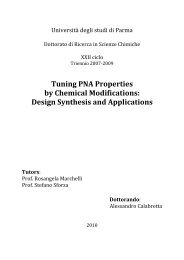Create successful ePaper yourself
Turn your PDF publications into a flip-book with our unique Google optimized e-Paper software.
Figure 3. Iron (expressed in log 10 scale), selenium, copper, and manganese levels in the EBC of the<br />
studied groups. Between-group differences in iron and copper were sought using the Kruskal-Wallis<br />
test (p 0.0001), followed by Dunn multiple comparison test (*p 0.05); one-way analysis of variance<br />
was used for selenium and manganese. The horizontal lines represent the median values of iron and<br />
copper, and the mean values of selenium and manganese.<br />
cause glutathione depletion and thus reduce its<br />
scavenging potential. It is worth noting that the study<br />
of transition metals in exhaled air may also help to<br />
assess the toxic lung effects of particulate air pollu-<br />
Figure 4. Spearman correlations between EBC copper levels<br />
and FEV 1 in COPD patients.<br />
tion (ie, particulate matter [PM] up to 10 m in<br />
diameter, and PM up to 2.5 m in diameter) because<br />
transition elements may modulate the toxic effects of<br />
PM up to 10 m in diameter by means of oxidative<br />
stress, 29 and there is now considerable epidemiologic<br />
evidence supporting a relationship between increased<br />
levels of particulate air pollution and increased<br />
morbidity and mortality due to respiratory<br />
diseases. 30<br />
Blood or urine levels of toxic metals may reflect<br />
their absorption, but exhaled toxic metal analysis<br />
may make it possible to assess metal dose at target<br />
tissue level. This may give rise to new therapeutic<br />
strategies (procedures and/or interventions aimed at<br />
altering the levels of trace element and toxic metals,<br />
such as the use of detoxifying and metal chelating<br />
agents or scavengers) in a disease for which no<br />
curative therapies are currently available. 1,31<br />
Although the changes in EBC manganese and<br />
selenium levels were not statistically significant, our<br />
COPD patients had reduced EBC copper and iron<br />
levels. This is at least partially in line with a study 32<br />
showing a decrease in the levels of various metals<br />
1294 Original Research<br />
Downloaded from<br />
chestjournals.org on May 23, 2007<br />
Copyright © 2006 by American College of Chest Physicians
















